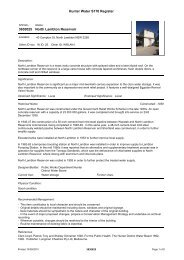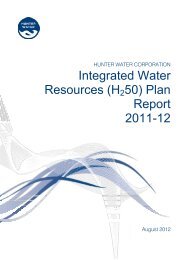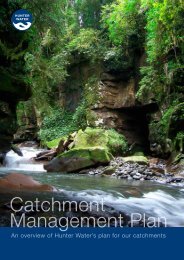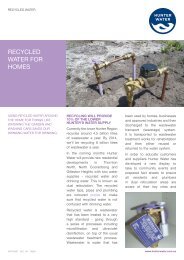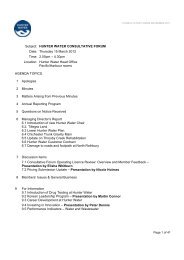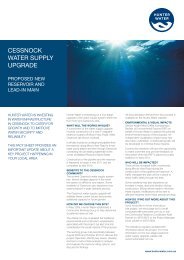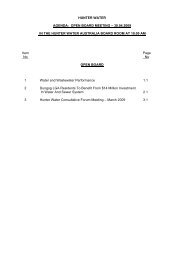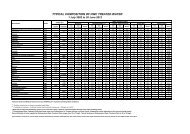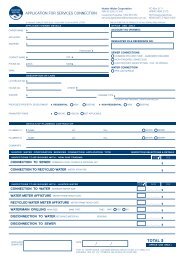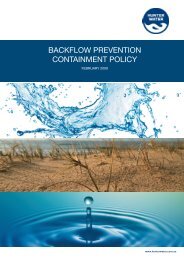Water Kit - Hunter Water
Water Kit - Hunter Water
Water Kit - Hunter Water
Create successful ePaper yourself
Turn your PDF publications into a flip-book with our unique Google optimized e-Paper software.
1.3 history of our water supply no.1<br />
Safe Harbour and Good <strong>Water</strong><br />
A large safe harbour, abundant fresh<br />
water, coal deposits and good soil<br />
attracted the first settlers to Newcastle<br />
and the <strong>Hunter</strong>. <strong>Water</strong> was obtained<br />
from streams, public wells and private<br />
storage tanks. Yet rapid growth in the<br />
1860s placed pressure on water<br />
supplies and quality. Droughts also<br />
threatened water supplies and future<br />
economic growth. More secure water<br />
supplies were essential.<br />
The Start Of Treated <strong>Water</strong><br />
Walka <strong>Water</strong> Works was completed by<br />
the Public Works Department in early<br />
1887. The <strong>Water</strong> Board took control in<br />
1892. It is located west of Maitland<br />
on the <strong>Hunter</strong> River and in 1887 had<br />
50,000 potential consumers. A 15<br />
inch pipe 37km long carried water<br />
to Newcastle. Those who could afford<br />
it had pipes and taps installed in their<br />
homes, others collected their water<br />
from public standpipes.<br />
Demand Greater Than Supply<br />
In 1912, just 20 years after the<br />
<strong>Water</strong> Board was formed, the<br />
population supplied with water had<br />
increased five fold. Industry was also<br />
growing rapidly, BHP opened in 1916<br />
increasing water demand. The choice<br />
for a second water source was to<br />
build a dam or extract water from<br />
sandbeds. Many rivers in the<br />
Barrington Tops were studied before<br />
deciding on the Chichester River.<br />
1903<br />
1864<br />
1887<br />
1916<br />
Hard Work and Health<br />
Concerns<br />
Storing and transporting water was<br />
time consuming and difficult. Pollution<br />
also posed a threat to water quality<br />
and public health; in 1878 a Lambton<br />
doctor said it was ‘not water at all, but<br />
mud’. The <strong>Hunter</strong> District <strong>Water</strong><br />
Supply and Sewerage Board was<br />
created in 1892 to provide safe and<br />
reliable drinking water to the public<br />
and industry - which of course was<br />
easier said than done.<br />
A CycleOf Drought and Flood<br />
As Walka had limited storage capacity<br />
the Lower <strong>Hunter</strong> was still affected<br />
by floods and drought. A flood in<br />
1893 caused major damage to the inlet<br />
structure and pipeline. Droughts<br />
in 1902-03 and 1905-06, and<br />
continued rapid growth, also raised<br />
the need to develop other water<br />
sources. The ‘hardness’ of <strong>Hunter</strong><br />
River water for domestic chores was<br />
also a cause of concern to local<br />
residents.<br />
Bushrangers and World War<br />
Chichester Dam lies north of Dungog<br />
in an area once known for bushrangers<br />
such as Thunderbolt and Joe<br />
Burn. Work began in 1916 during the<br />
First World War, with more than 1000<br />
men, women and children living in the<br />
construction village at Dusodie.<br />
The dam is surrounded by state forests<br />
which makes it one of the most<br />
protected and pristine catchment<br />
areas in Australia.<br />
1875<br />
1903<br />
1924<br />
<strong>Water</strong> kit . ssS . 001 . april 2010 8




